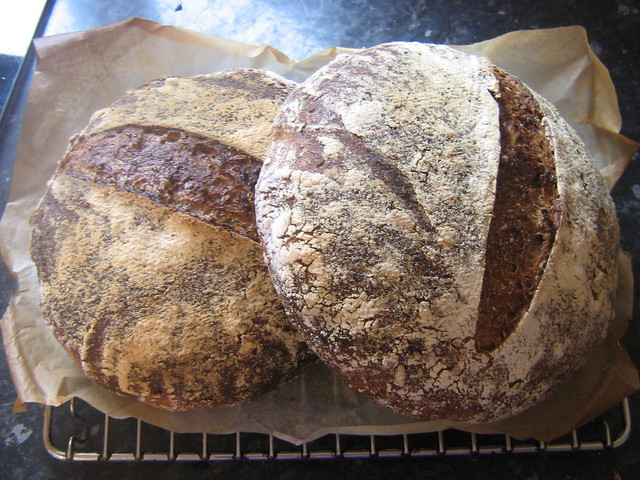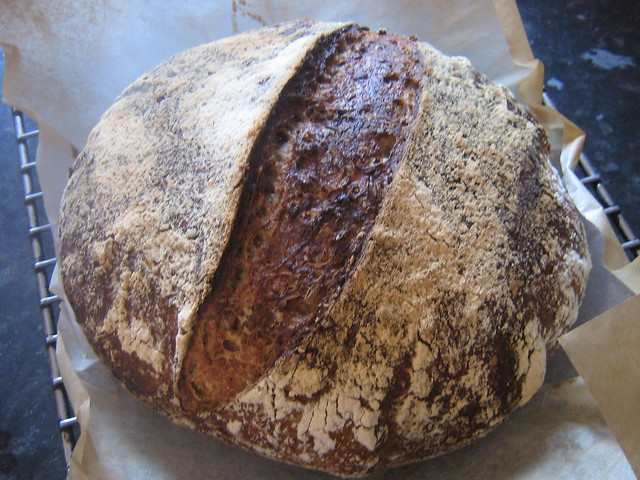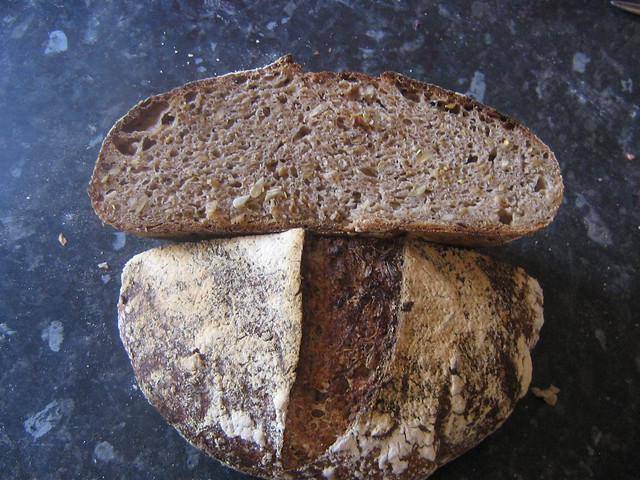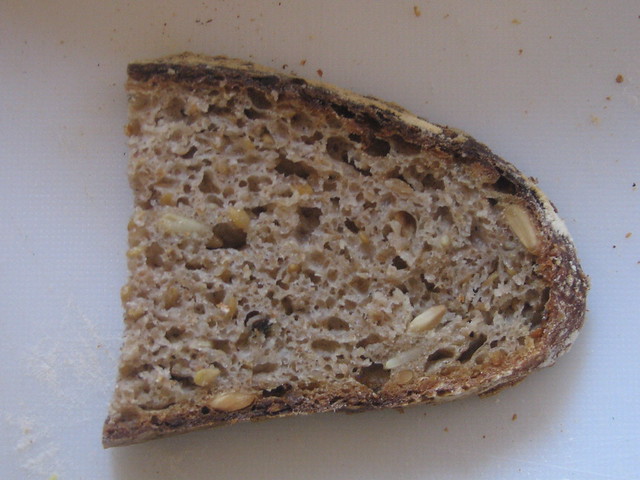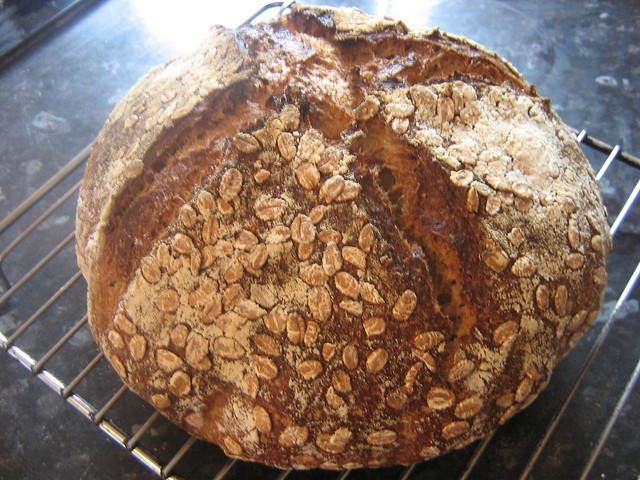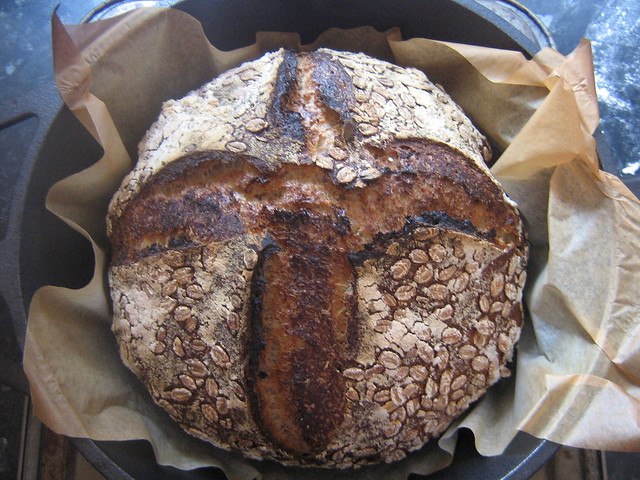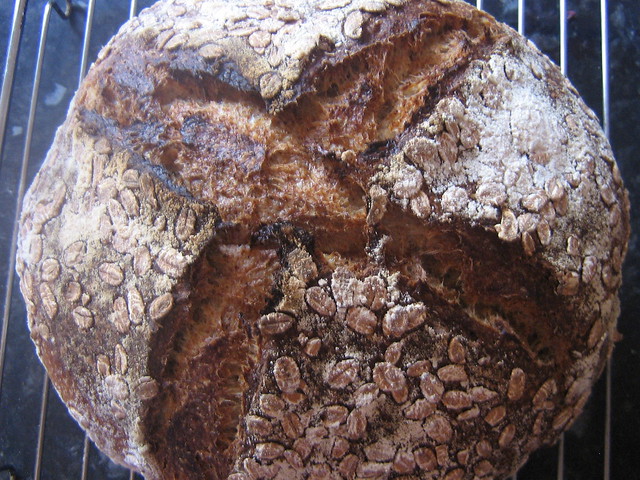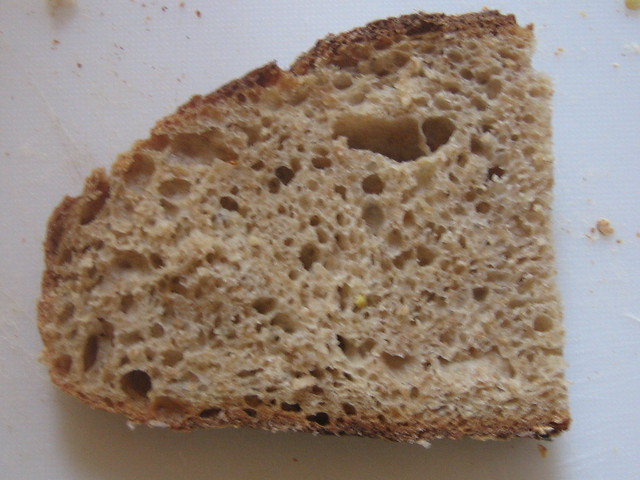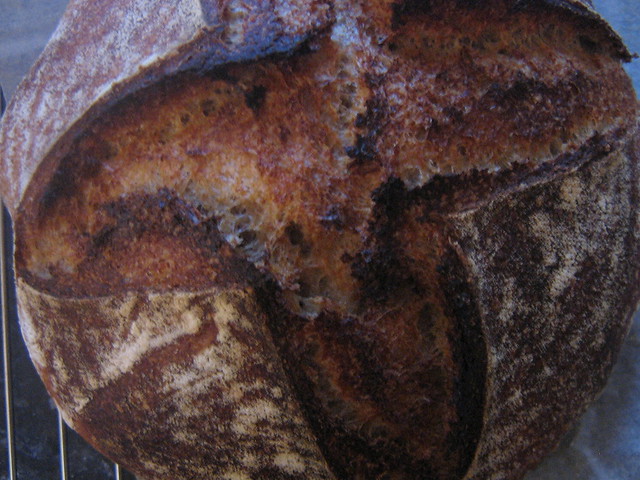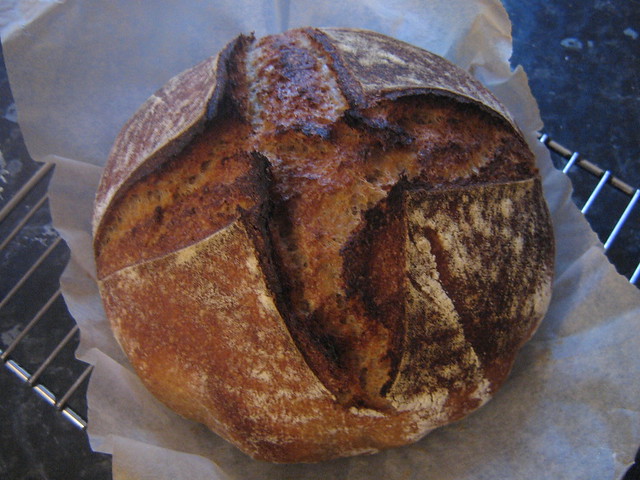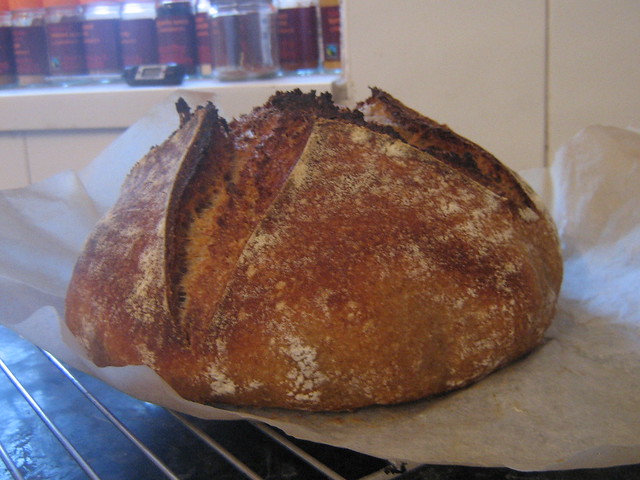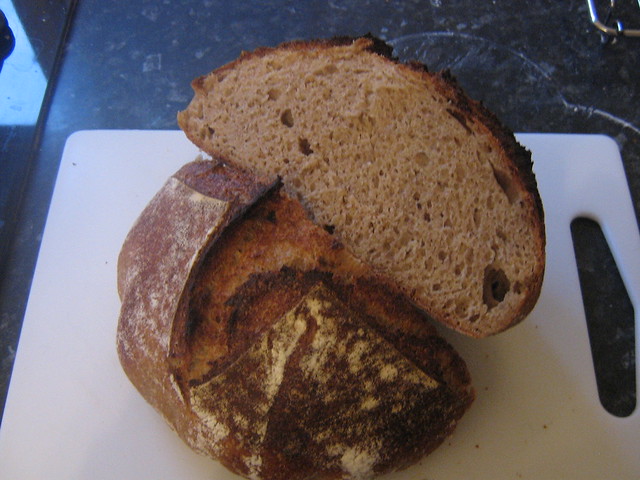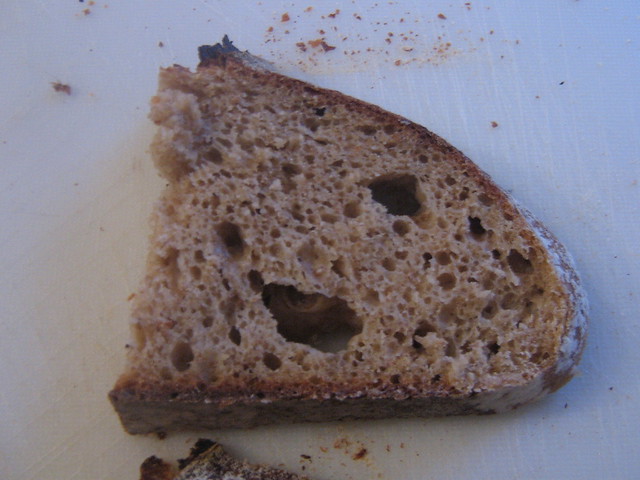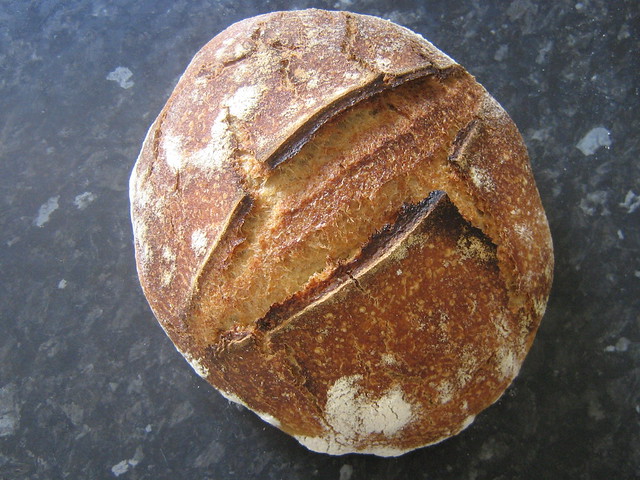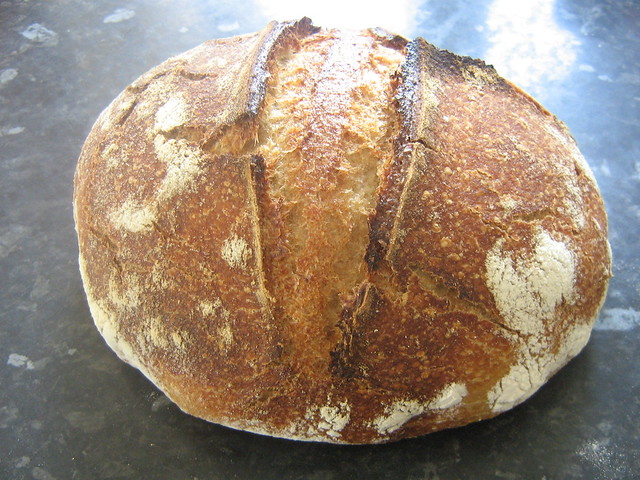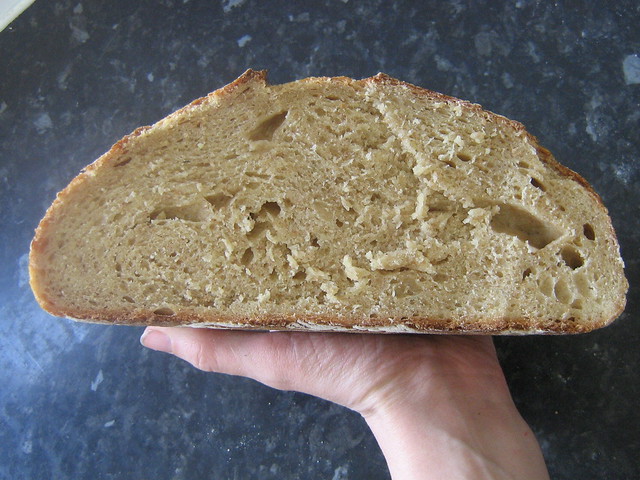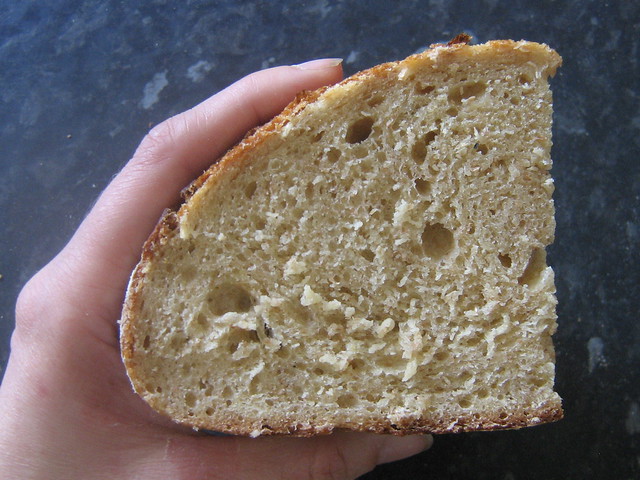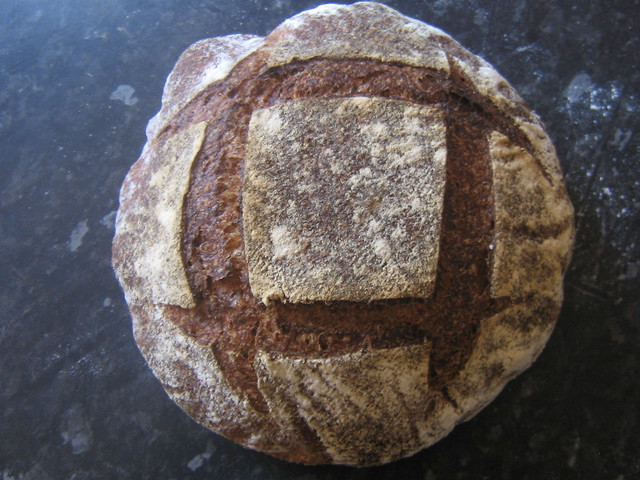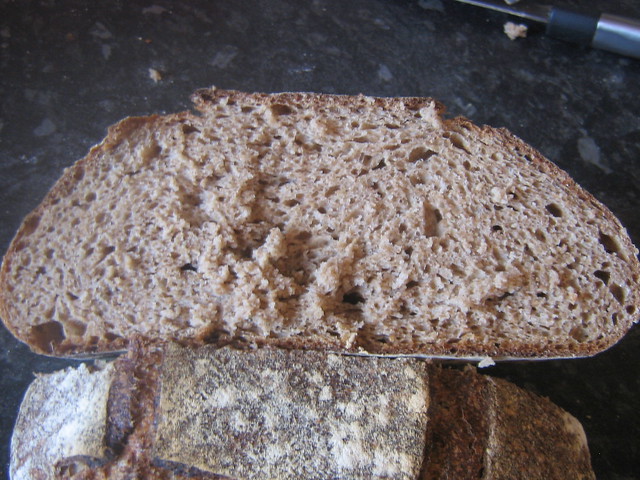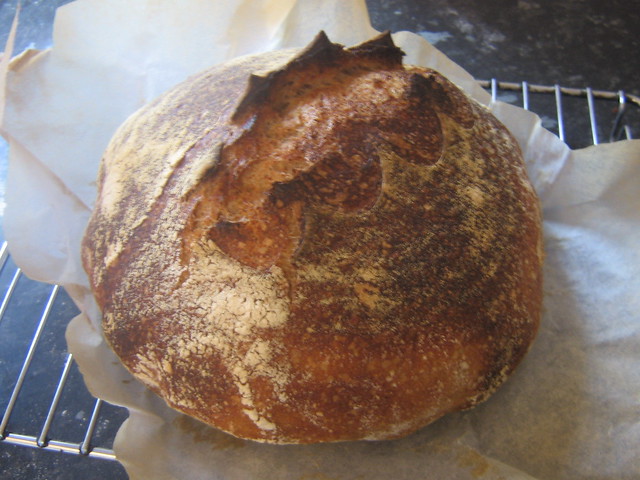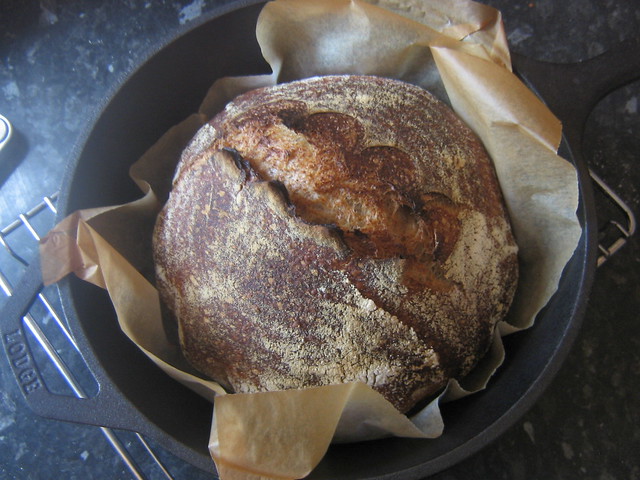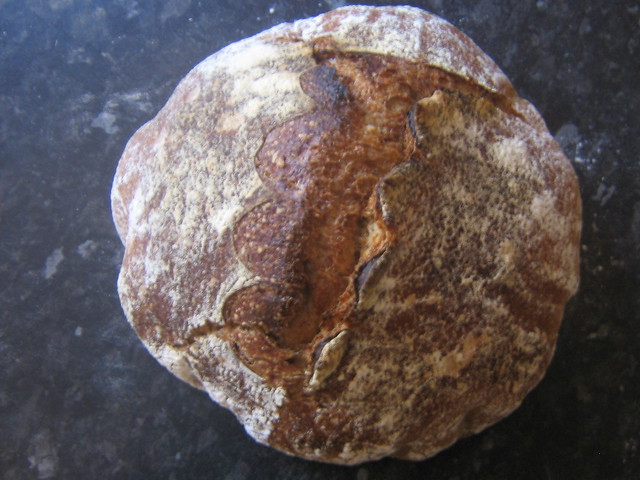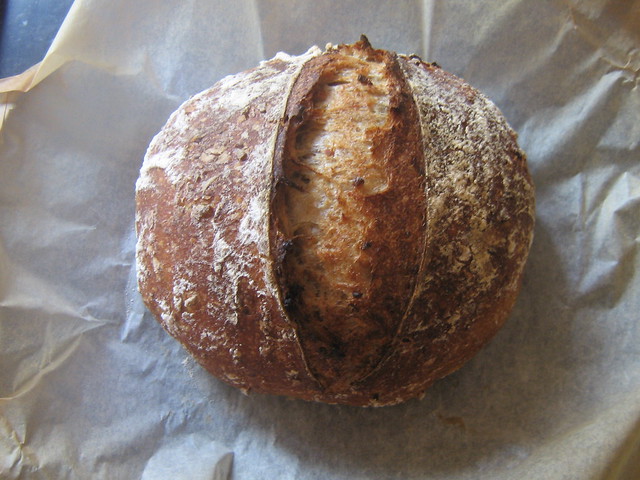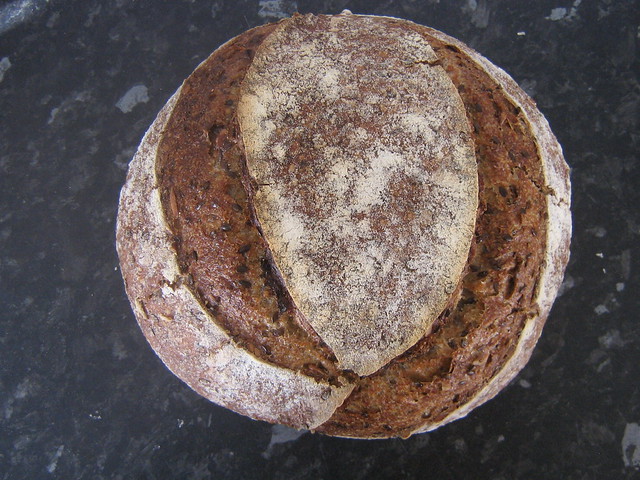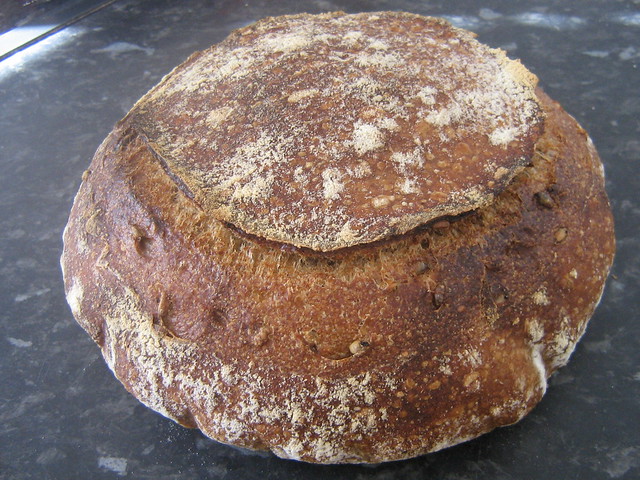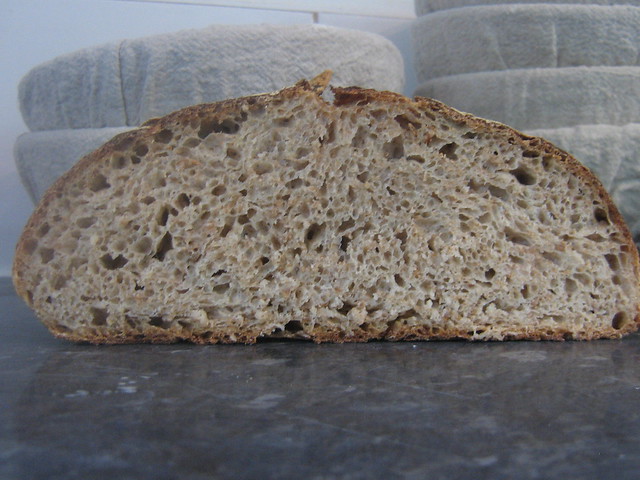This week my DH looked positively radiant when unpacking some midweek shopping. “You'd never guess what I found,” he said rooting about in his backpack “Hmm, extra bananas, milk…” so far so normal. I don't usually get a item by item review of his shopping lists so I thought “This had better be worth it”. “Ooh, here it is….” he says producing with a flourish… a bag of Doves Farm Wholemeal Rye flour.
Does this count as breaking my promise to use up things in the cupboard before buying more flour or grains? I hope not. It was a cute gesture. Plus I hadn't actually told him I'd banned myself from buying new flour.
20% Rye bread with added sunflower and flax seeds
First up this week, a classic combination of add-ins with the 20% Rye recipe from Tartine #3. I am very fond of this recipe as a basic country-style loaf. It is enough rye to contribute to the taste of the finished bread without having to adopt any rye specific techniques.
I scaled the recipe to a total of 400g of added flour per loaf. This is because I have found that with add-ins, 500g of added flour per loaf is too much for my bannetons. As usual, due to cool weather, I increased the percentage starter to 30% (adjusting added high extraction flour and water to compensate). Finally, I increased the hydration a little as I expected the sunflower seeds and flaxseeds would absorb quite a bit of liquid.
The sunflower seeds (115g) were toasted in advance in a clean frying pan. The flaxseeds (115g) was soaked overnight in 150ml of cool water. Immediately after shaping, the loaves were retarded in the fridge for about 12 hours.
So the loaf came out fairly flat and probably would have come out more flat without the Dutch oven for support. The loaves did not have much vertical oven spring and mostly spread outwards rather than upwards. Quite possibly accidentally a little too much extra water or over-fermented.
While not entirely perfect, I'll be happily spreading honey, jam or peanut butter on it for the rest of the week.
Spelt and Wheat bread
This recipe is a cautious attempt at making bread with spelt flour. Overall there is 40% spelt flour and 60% wheat flour.
The recipe calls for 300g high extraction spelt flour and 100g whole grain spelt flour. Instead I used 200g white spelt flour and 200g whole grain spelt flour. I'm a little wary of spelt so reduced the water added in the final mix by 5% and tried to manipulate the dough the minimum possible amount.
The spelt flakes on the outside made scoring a little more challenging than usual. Taste wise, beautifully creamy coloured soft crumb and a thin crispy crust. However, I'm not sure I could tell there was spelt flour in there from the taste alone.
Finally, while waiting for the bread to rise I baked a marble cake from this book.
Happy Baking!
Sunday 31 January 2016
Tuesday 19 January 2016
Running out of Rye: khorasan bread and white maize and wheat sourdough
Deciding what to bake this week has been a challenge. Initially I was thinking of baking a 40-60% rye bread as we haven't had one of those for months. Last week I'd finished a small bag of wholegrain rye flour and thought nothing more of it as I usually have a few spare. Over the last year, I've been collecting various types of flours, grains and seeds so there are a good few things in my baking supplies cupboard that I've half forgotten about. After checking the entire content of the hoard, I found no wholegrain rye flour but three bags of Khorasan flour from Shipton Mill.
Having taken stock, I have decided it is time for a temporary moratorium on purchasing further baking ingredients. That rye bread will have to wait for a while longer.
60% Khorasan
There is something about Khorasan I find irresistible. Maybe it is the yellow colour. Maybe its that it seems to have less tannins and hence less bitterness than modern wheat. Maybe it is because it was the first ancient grain I successfully baked with. Maybe it is that it is easier to deal with than einkorn, emmer and spelt.
This week I increased the percentage starter to 30% (adjusting added high extraction flour and water to compensate) and increased the hydration a little. Including the flour and water in the starter there was 1,145g of flour and 975g of water which makes the overall hydration about 85%. Immediately after shaping, the loaves were retarded in the fridge for 14 hours.
The crumb is soft and very tasty. Somehow, I'm not entirely satisfied with this loaf but I don't know what could be improved. Perhaps it is the tiredness and frustration caused by the other loaves I baked this week.
Maize and Wheat bread
This recipe is from Dan Lepard's book The Handmade Loaf. The Homemade Loaf was the first ses leftover cooked polenta. At the time, I looked up the recipe only to be disappointed that I bread book I bought back in 2013 and I'm still fond of the simple methods and spectacular results.
On New Year's Eve, I was cooking baked chicken with a spicy polenta crust and remembered the recipe for maize bread in this book but didn't have enough maize flour. However, Dan's book contains two recipes for maize bread, a sourdough version and a straight dough version with added polenta.
As I've not baked the sourdough version before, this discovery ultimately lead down the rabbit hole to buying maize flour from Eighth Day. The maize flour is this one from infinity foods. Upon opening it turned our to be yellow rather than white maize.
I doubled the recipe to make 2 large loaves and used a mixture of 200g live yoghurt and 450g water instead of the whey. This did change the length of the final proof. After 2 and a half hours the dough was pretty much unchanged. After 4 hours, the dough had barely risen but I decided to bake them anyway as I wasn't willing to be baking in the middle of the night.
Overall, I'm pleased with the outcome. The maize bread has a fantastic soft texture – perfect for hagelslag or toast.
Happy Baking!
Having taken stock, I have decided it is time for a temporary moratorium on purchasing further baking ingredients. That rye bread will have to wait for a while longer.
60% Khorasan
There is something about Khorasan I find irresistible. Maybe it is the yellow colour. Maybe its that it seems to have less tannins and hence less bitterness than modern wheat. Maybe it is because it was the first ancient grain I successfully baked with. Maybe it is that it is easier to deal with than einkorn, emmer and spelt.
This week I increased the percentage starter to 30% (adjusting added high extraction flour and water to compensate) and increased the hydration a little. Including the flour and water in the starter there was 1,145g of flour and 975g of water which makes the overall hydration about 85%. Immediately after shaping, the loaves were retarded in the fridge for 14 hours.
The crumb is soft and very tasty. Somehow, I'm not entirely satisfied with this loaf but I don't know what could be improved. Perhaps it is the tiredness and frustration caused by the other loaves I baked this week.
Maize and Wheat bread
This recipe is from Dan Lepard's book The Handmade Loaf. The Homemade Loaf was the first ses leftover cooked polenta. At the time, I looked up the recipe only to be disappointed that I bread book I bought back in 2013 and I'm still fond of the simple methods and spectacular results.
On New Year's Eve, I was cooking baked chicken with a spicy polenta crust and remembered the recipe for maize bread in this book but didn't have enough maize flour. However, Dan's book contains two recipes for maize bread, a sourdough version and a straight dough version with added polenta.
As I've not baked the sourdough version before, this discovery ultimately lead down the rabbit hole to buying maize flour from Eighth Day. The maize flour is this one from infinity foods. Upon opening it turned our to be yellow rather than white maize.
I doubled the recipe to make 2 large loaves and used a mixture of 200g live yoghurt and 450g water instead of the whey. This did change the length of the final proof. After 2 and a half hours the dough was pretty much unchanged. After 4 hours, the dough had barely risen but I decided to bake them anyway as I wasn't willing to be baking in the middle of the night.
Overall, I'm pleased with the outcome. The maize bread has a fantastic soft texture – perfect for hagelslag or toast.
Happy Baking!
Labels:
Kamut,
khorasan,
Maize Flour,
Tartine #3,
The handmade loaf,
White Maize and Wheat
Tuesday 5 January 2016
Basic Whole Wheat and 10% Rye
The last of the stollen and speculaas biscuits have been eaten. The Christmas decorations are back in their box gathering dust. The weather in Manchester is about as depressing as physically possible so it must be time for the first few loaves of 2015.
50% Whole Wheat
A 50% Whole wheat, 50% high extraction with 87.5% hydration loaf inspired by the first recipe in Tartine #3 - White-Wheat Blend (Ode to Bourdon)
As usual I increased the amount of leaven to 30% and reduced the water and high extraction flour added to the final mix to compensate. The bread got some extra slap-and-folds when the salt is added. One loaf was baked after a 3 hour final fermentation at room temperature, whereas the other loaf was baked the following morning after 14 hour final fermentation in the fridge.
We don't really have white whole wheat available in the UK. The whole wheat flour I use is this one from Shipton Mill and is quite pink in colour. The high extraction wheat flour I use is this one from Bacheldre Watermill which is very pale, creamy and a little yellow.
Previously, I've either bolted the Shipton Mill whole-wheat or made a 50-50 mix of whole-wheat to white flour both of which are quite heavy compared to the Bacheldre high extraction flour. Making this switch has lightened the results from Tartine #3 recipes substantially.
10% Rye
A light country bread with a sprinkling of rye - 40% high extraction flour, 40% White flour, 10% whole wheat and 10% Rye and 85% hydration.
This dough seemed quite wet and sticky. Rather than add more flour, I upped the amount of slap-and-folding to about 10 minutes. The loaves got the 'Stegosaurus' score as the loaf fermented at room temperature seemed quite delicate and I didn't trust myself to score it with a fruit knife!!
A note on crumb shots and hydration
As you can see the crumb on my bread is nothing at all like the beautiful crumbs pictured in the book. There is I think two possible reasons for this:
1) Flour choice. I am using a relatively soft white wheat flour (this one from Shipton Mill), which is possibly not as strong as American flour and might not be the perfect choice for long fermentation.
2) Hydration. I increased the water in the 50% whole wheat bread until the texture was moderately loose but this is still not really 'high hydration' given the amount of bran and germ in the bread. In the case of the 10% Rye bread, I could have the opposite problem of too much water.
In both cases, I'm not really bothered by the lack-of-holes issue, for me the purpose of high(-er) hydration multi-grain breads is to have a soft, even, light crumb without having to enrich the dough. My comparison point being the wholegrain breads in Reinhart's book which were on occasion disappointingly rough.
Happy Baking!
50% Whole Wheat
A 50% Whole wheat, 50% high extraction with 87.5% hydration loaf inspired by the first recipe in Tartine #3 - White-Wheat Blend (Ode to Bourdon)
As usual I increased the amount of leaven to 30% and reduced the water and high extraction flour added to the final mix to compensate. The bread got some extra slap-and-folds when the salt is added. One loaf was baked after a 3 hour final fermentation at room temperature, whereas the other loaf was baked the following morning after 14 hour final fermentation in the fridge.
We don't really have white whole wheat available in the UK. The whole wheat flour I use is this one from Shipton Mill and is quite pink in colour. The high extraction wheat flour I use is this one from Bacheldre Watermill which is very pale, creamy and a little yellow.
Previously, I've either bolted the Shipton Mill whole-wheat or made a 50-50 mix of whole-wheat to white flour both of which are quite heavy compared to the Bacheldre high extraction flour. Making this switch has lightened the results from Tartine #3 recipes substantially.
10% Rye
A light country bread with a sprinkling of rye - 40% high extraction flour, 40% White flour, 10% whole wheat and 10% Rye and 85% hydration.
This dough seemed quite wet and sticky. Rather than add more flour, I upped the amount of slap-and-folding to about 10 minutes. The loaves got the 'Stegosaurus' score as the loaf fermented at room temperature seemed quite delicate and I didn't trust myself to score it with a fruit knife!!
A note on crumb shots and hydration
 | 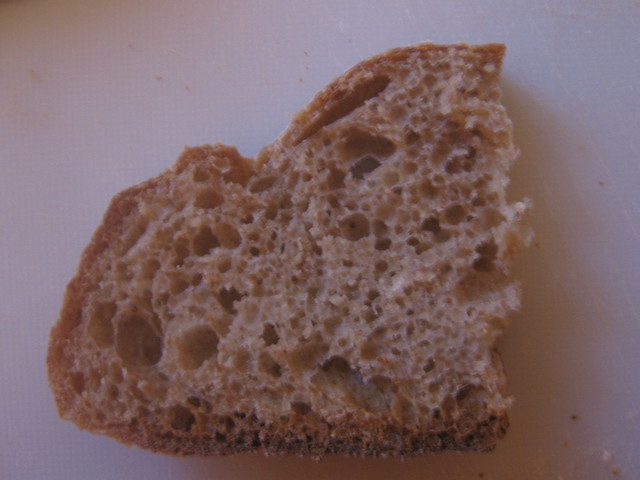 |
As you can see the crumb on my bread is nothing at all like the beautiful crumbs pictured in the book. There is I think two possible reasons for this:
1) Flour choice. I am using a relatively soft white wheat flour (this one from Shipton Mill), which is possibly not as strong as American flour and might not be the perfect choice for long fermentation.
2) Hydration. I increased the water in the 50% whole wheat bread until the texture was moderately loose but this is still not really 'high hydration' given the amount of bran and germ in the bread. In the case of the 10% Rye bread, I could have the opposite problem of too much water.
In both cases, I'm not really bothered by the lack-of-holes issue, for me the purpose of high(-er) hydration multi-grain breads is to have a soft, even, light crumb without having to enrich the dough. My comparison point being the wholegrain breads in Reinhart's book which were on occasion disappointingly rough.
Happy Baking!
Review of 2015
Happy New Year!
I've been distracted for a few months but have made a new years resolution to post more and improve my bakes even more. I'm going to cook my way through Tartine #3 and post at least 2 loaves a week. Some recipes will be excluded either because I can't source the ingredients or don't like the taste of a particular grain (I'm looking at you buckwheat!).
Last June, I bought a Dutch oven and my bread radically improved immediately due to an even heat from below. The results were so exciting and a huge confidence boost. In September I started some voluntary work and forgot a little about documenting the outcomes. In November my fridge broke down making retarding loaves overnight impossible and further complicating fitting baking around the rest of my schedule.
Below is a selection of bakes from 2015, unfortunately I don't have a record of what most of them were.
Anyway, new year, new fridge, new start.
Subscribe to:
Posts (Atom)
